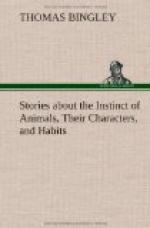“I heard of it, Boys, though I did not see it. It was a baboon, and one of the largest of the species.—It was what is called the dog-faced baboon.”
“Where do such animals come from, Uncle Thomas.”
“From Africa, John, and I believe they are not to be found elsewhere. They are very fierce and mischievous creatures, and are said sometimes even to attack man, but this I believe to be an exaggeration. Immense troops of them inhabit the mountains in the neighbourhood of the Cape of Good Hope, whence they descend in bands to plunder the gardens and orchards. In these excursions they move on a concerted plan, placing sentinels on commanding spots to give notice of the approach of an enemy. On the appearance of danger, the sentinel utters a loud yell, upon which the whole troop retreats with the utmost precipitation.”
“Do they carry the spoil with them when they are thus disturbed, Uncle Thomas?”
“When disturbed they are said to break in pieces the fruit which they have gathered, and cram it into their cheek pouches—receptacles with which nature has furnished them for keeping articles of food till they are wanted.
“Le Vaillant, a traveller in Africa, had a dog-faced baboon which accompanied him on his journey, and he found its instinct of great service to him in various ways. As a sentinel he was better than any of the dogs. So quick was his sense of danger, that he often gave notice of the approach of beasts of prey, when every thing else seemed sunk in security. He was also very useful in guarding the people of the expedition from danger, from using unwholesome or poisonous fruits. The animal’s name was Kees. Here is the very interesting account which his master gives of him.
“Whenever we found fruits or roots, with which my Hottentots were unacquainted, we did not touch them till Kees had tasted them. If he threw them away, we concluded that they were either of a disagreeable flavour, or of a pernicious quality, and left them untasted. The ape possesses a peculiar property, wherein he differs greatly from other animals, and resembles man,—namely, that he is by nature equally gluttonous and inquisitive. Without necessity, and without appetite, he tastes every thing that falls in his way, or that is given to him. But Kees had a still more valuable quality,—he was an excellent sentinel; for, whether by day or night, he immediately sprang up on the slightest appearance of danger. By his cry, and the symptoms of fear which he exhibited, we were always apprized of the approach of an enemy, even though the dogs perceived nothing of it. The latter at length learned to rely upon him with such confidence, that they slept on in perfect tranquillity. I often took Kees with me when I went a hunting; and when he saw me preparing for sport, he exhibited the most lively demonstrations of joy. On the way he would climb into the trees, to look for gum, of which he was very fond. Sometimes he discovered to me honey, deposited




